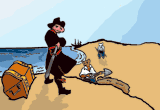Card reading: Spreads
![[sample]](card/22.gif)
This is a short guide to cartomancy spreads with the Decktet.
As with any interpretive deck, there are many possible spreads. You can use your favorite or mine books on tarot reading for ideas, but avoid spreads that use more than a dozen cards. Here are a few spreads to get you started.
See also: the guide to interpreting the cards.
A warning, in case it is necessary: Cards should not dictate major life decisions, especially if they tell you something that defies all reason and prudence. When the Windfall appears as your future card, don't start spending the money until and unless a check actually arrives.
Some practitioners are insistent that you should allow the subject of the reading to shuffle the deck three times. If you do this, perform the reading after their shuffling without cutting or reshuffling the deck.
The Diamond
![[diamond]](spread-diamond.gif)
This is a simple spread that makes use of special features of the Decktet. It is good for answering specific questions, but not so good for general readings.
Shuffle the deck and set it on the table in front of you. If you want the reading to address a specific question, ask it aloud at this time.
Now pick up the cards and begin dealing cards face up into a stack. Stop when you have dealt a personality card. Then begin dealing cards into a second stack; stop when you have dealt a location card. (Location cards have a divided circle in front of the card name.) Then a third stack; stop when you have dealt an event card. (Event cards have a filled circle in front of the card name.) Then a forth stack; stop when you have dealt an ace.
If you deal through the whole deck without completing the four stacks, then the cards will not speak on this matter-- put the kettle on and make a cup of tea. If you complete all four stacks, set aside the deck. The spread consists of the four cards on the tops of the stacks.
If your question could be answered by a yes or a no, the answer may be interpreted in this way: If the ace in the spread is a Sun or Knot, then the deck says yes. If the ace was is a Wave or Leaf, then the answer is no. If the ace is a Wyrm, then there is no direct answer-- matters are more complicated than that. If the ace is a Moon, then there is something more important than your question that the cards have addressed.
In addition, the ace in the spread serves to set the tone of the answer. Other cards that share a suit with the ace should be read as more significant than cards that do not.
The other cards in the spread should be read as describing a significant person, place, and time relevant to the matter at hand. If there was no specific question, they will describe whatever matter has been or will be important to the subject of the reading.
The Window
![[window]](spread-window.gif)
This spread provides an open tableaux and invites open-ended interpretations.
Deal out nine cards in three rows of three, so as to make a box. Then deal a tenth card to one side.
The last card is the focus card and sets the tone for the other nine. The first row of three cards represent the past, the middle row the present, and the third row future.
Pay careful attention to suits that occur in both the past, present, and future, especially if they are also shared by the focus card. These mark important threads that run through the fortune.
Personality cards may represent people in the subject's life, but they might instead represent the subject themself. If the subject faces choices or changes, then multiple personality cards may represent the subject.
The Bow
![[bow]](spread-bow.gif)
This is a more focussed spread than the Window, without being about a specifically formulated question. If addressed to a given problem, it can be used to see the bigger picture.
Deal out eight cards in the configuration shown. You may wish to deal them out face down and turn them over one at a time, interpreting each in turn.
- focus: This sets the tone. Take note of later cards that match suits with the focus.
- present: This summarizes the status quo, what is going on now.
- immediate past: The immediate past may be the last few days or the last few years, depending on the context, but it is more recent than the distant past.
- resource: This is something from the past that is relevant to the future.
- distant past: This is the earliest time relevant to the matter. It is at least as far back as the resource, perhaps further.
- immediate future: This may be the next few days, the next few months, or even the next year. It is the time leading up to and into the obstacle
- obstacle: This is the challenge the future has in store. If it is a positive card, then perhaps there are no obstacles worth mentioning.
- distant future: This typically represents the time after the obstacle. The aftermath or one possible resolution.
![]()
![]()
![]()
![]()
![]()
![]()
![]() The Decktet is ©2008-10 P.D. Magnus. Some rights reserved. The contents of this page and a version of the deck are offered as open content under a Creative Commons Attribution NonCommercial ShareAlike 3.0 License. Permissions beyond the scope of this license may be negotiated.
The Decktet is ©2008-10 P.D. Magnus. Some rights reserved. The contents of this page and a version of the deck are offered as open content under a Creative Commons Attribution NonCommercial ShareAlike 3.0 License. Permissions beyond the scope of this license may be negotiated.

